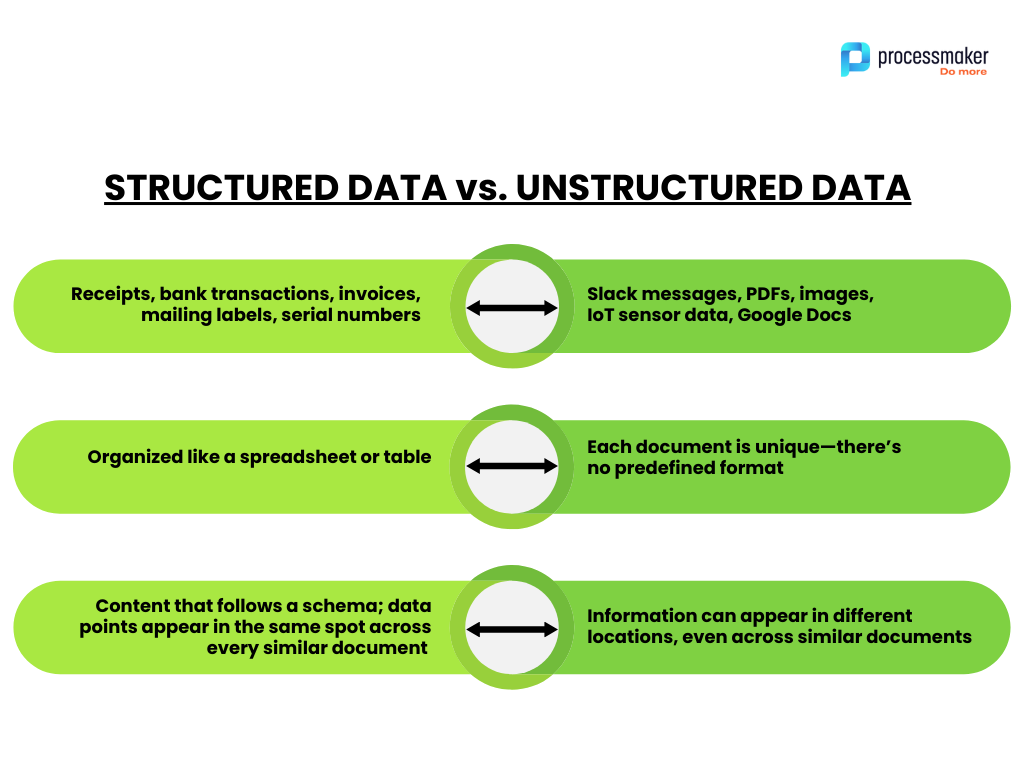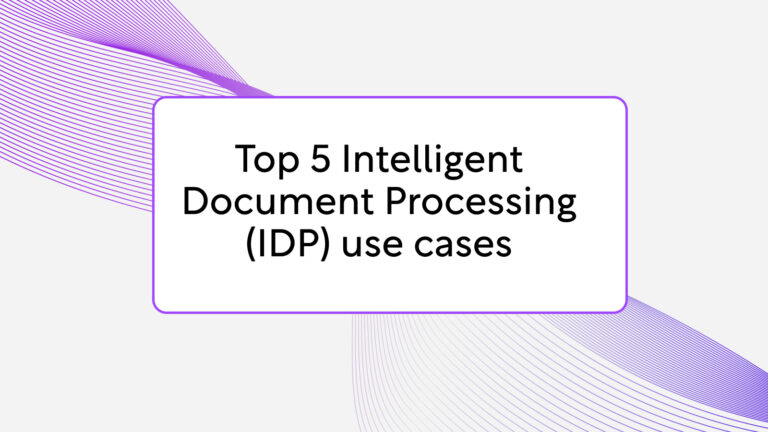Intelligent document processing (IDP) is one of the top three AI tools topping the automation success charts. Today, nearly 4 out of 10 organizations are piloting IDP-related projects.
AI-infused intelligent process automation like IDP is so favored, that McKinsey sets a new priority for C-suites in 2024: Find untapped ways to outthink competitors tinkering with similar tech.
It’s no longer if you’re using hyperautomation, but how you’re using it. When everyone’s clamoring for a unique spin on a widespread strategy, Hyper-Productivity is the way top automation leaders are securing gains other organizations are missing out on.
What is Intelligent document processing?
Intelligent document processing (IDP) is a branch of AI and computer vision tools rewired for business. You see similar technologies at play every day. Semi-autonomous cars can differentiate between discarded fast-food containers and K-rails. Our smartphones automatically organize photos of Aunt Jeanine and our college best friend into separate albums.
Using what’s called Optical Character Recognition (OCR), IDP can pluck information from the real world and help computers make sense of it. Upload a mortgage application, and IDP can “read” its contents to self-extract information like first name, address, and social security number. It uses a set of digital eyes to strip important information in printed paperwork, photos, and scanned documents—all without human intervention. IDP is the better and more intuitive alternative to robotic process automation (RPA).
Another technology, Natural Language Processing (NLP) gives IDP even more power than a conventional scan. You’ve seen this one turning the wheels of AI tools like ChatGPT and Google Gemini. IDP not only gathers facts from documents but can understand their context as well.
Is this customer review positive or negative?
I’ve never seen a document formatted quite like this, but it shares enough similarities with other agreements that I know it’s a contract.
These are just a couple of ways IDP reasons with documents to help your team organize, search, and make sense of your data.
Hyper-Productivity and automated document processing
With IDP, document content becomes readily usable. Paired with other automated tasks, you can edit it, search within, or copy-and-paste it to another location. Documents most important to your organization—applications, request forms, meeting notes, invoices—are instantly fed into your systems in a flash.
IDP is an AI-powered expert at reading and organizing all sorts of data. It can be a structured document, where information typically appears in the same place. Think of a receipt an employee submits for reimbursement.
Typically, the business name appears at the very top, with items and their costs organized below. Even before the AI-everywhere era, software bots, like RPA, aced extracting data from rigidly organized documents.
But IDP takes it a step further by mastering unstructured data, too. For instance, it can automatically identify information in a loosely structured document, like an image. See for yourself: take a photo of a phone number with your smartphone and it’ll prompt you to dial it. Or, test-drive ProcessMaker’s AI Data Extraction tool with an ID of your own.

Now think of this on an organization-wide level, combing through millions of documents to pinpoint the exact information you need. Then, execute a set action based on its findings. IDP drops document content into your processes.
Imagine it in action:
- Extract details from a paper invoice: The information then flows through an automated payment workflow. The system automatically knows how much the invoice is for—$400—and decides what to do based on the data extracted by IDP.
Your rules engine pays invoices under $500 automatically. Voila—Scanned, validated, and paid without any fuss. (Try building your own invoice approval process just by describing what you need in a few words!)
- Populate a customer database with handwritten forms: From credit unions to medical offices, many industries still rely on clients to complete paperwork by hand. Instead of hand-keying information like phone number and email address—simply leave it to IDP. IDP pulls data intuitively, even from those customers or patients that always mix-up form fields.
- Run customer details through Know-Your-Customer Checks: IDP can extract personal identifiers from thousands of government-issued IDs like passports and driver’s licenses from around the globe. Instead of waiting for a staffer to manually type a name into an Anti-Money Laundering database, create a self-driving IDP sequence. IDP can capture customer details and usher it through an automated process that queries for known fraudsters—all in seconds.
With IDP, you can up the ante on document automation and start enjoying 2024’s performance multiplier: Hyper-Productivity.
Benefits of combining Intelligent Document Processing and Hyper-Productivity
Here’s why IDP is ramping up Hyper-Productivity gains for 2024:
- Without automation tools, 60–73% of all enterprise data goes unprocessed, unnoticed, or unanalyzed. IDP’s knack for speed-reading thousands of documents is great news for organizations inundated with data. Not only will you finally make a dent in your processing backlog, but you can increase average response time and, therefore, customer satisfaction. IDP also helps you unearth creative insights from previously inaccessible data—and find those very gems that might be the key to outsmarting the competition.
- Manual processing is a huge drain on resources. One study reveals that manually processing invoices can cost you up to $9 each. AI and automation team up to drive down costs to less than $1.50 often teetering on near-zero.
- IDP touts a 99% accuracy rate, which is great news for operations that rely on manual data entry. On the flip side, 90% of spreadsheets contain errors. From overselling tickets to the 2012 Olympic Games to underreporting COVID cases, innocent mistypes often slink their way into formulas or customer communication and spiral into disaster.
- Impossible to find documents that devour productivity gains. One study reveals that at a company of 2,000 employees, 16,000 per week are wasted tirelessly scouring documents for needed information. A wild-goose chase ensues; no one is sure which document is most up-to-date and a simple info grab can turn into several back-and-forth emails. IDP puts the right information at every team member’s fingertips.
See how IDP changes the game compared to RPA tools you might currently use.
See IDP & Hyper-Productivity in Action
KPN, a top telecom company in Europe, struggled with the document wild-goose chase problem. With a vast number of contracts to maintain, storing paper copies in filing cabinets was no longer workable. Sales managers would request to see the details of an agreement and the hunt was on—staffers spent hours rummaging for the current version.
They rewired their strategy with a Hyper-Productivity mindset. Using IDP, they uploaded 2 million paper contracts into the cloud. Through automated metadata extraction, digital versions were instantly searchable.
Better yet, their metadata was now intelligent. Instead of simply yanking basic details straight from the document—like title or vendor name—IDP learned about the document through Natural Language Processing. KPN employees could browse for more nuanced clues vs. strict search terms.
Instead of collecting dust in a basement office, IDP flung archival data into the light, revealing valuable new insights and upping overall productivity across teams.
The number of documents rushing into your organization is not going to slow down: by all accounts, data is set to increase dramatically over the next decade. Processing and managing manually is no longer possible, and there’s no more room for human errors. To make sure you don’t just stay ahead of the competition but continually outperform it, IDP is the next step in your digital transformation journey.






